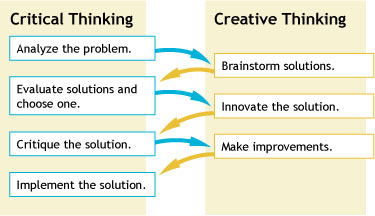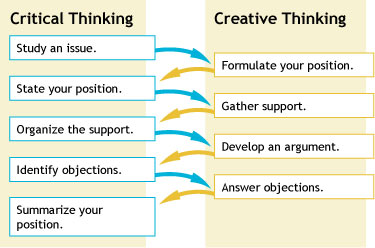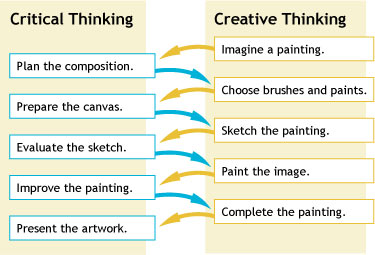Which is more important for today’s students, critical thinking or creative thinking? It’s a trick question. I may as well ask which is more important, breathing out or breathing in? “Whichever one I need to do right now” is one good answer to this last question. Another is “Neither—since I need both to stay alive.” It’s the same with critical and creative thinking.
The Thought Exchange
Creative and critical thinking are two halves of a cycle: inspiration and expiration.
- Creative thinking draws in possibilities. It is an expansive process, filling you with new ideas from the outside. Creativity reaches beyond what is known and into the unknown . . . to discover something new. Creativity is not necessarily discerning. You don’t separate the nitrogen from the oxygen in the air before you breathe it in. Your chest simply expands, and in it comes. Creative thinking can be exhilarating, flooding you with new possibilities.
- Critical thinking, on the other hand, sorts through the possibilities to do something practical. Critical thinking analyzes, applies, and evaluates. It categorizes, compares, contrasts, and traces causes and effects. It’s like separating the oxygen out of the air you breathe in, in order to enrich your cells, or extracting the carbon dioxide from your blood, in order to exhale it. Critical thinking takes what creative thinking has amassed and sorts it, keeping the best and discarding the worst.
Thinking as Respiration
All sorts of activities require this exchange between critical and creative thinking. The following charts examine a number of them:
Solving a Problem

Building an Argument

Painting a Picture

Respiration in All Things
You’ve seen how we move back and forth between critical and creative thinking as we solve a problem, build an argument, or even paint a picture. You don’t need another nifty chart to realize that most of what we do requires this sort of exchange: inspiration and expiration. Creative and critical thinking are basic to our lives, as close to us as breathing.